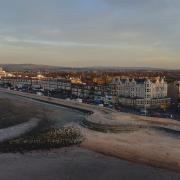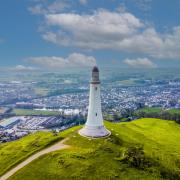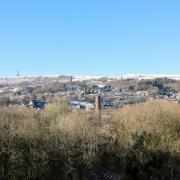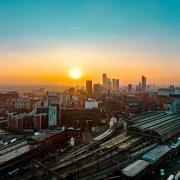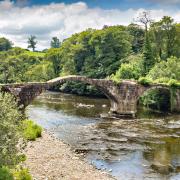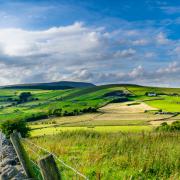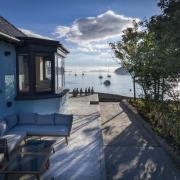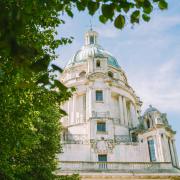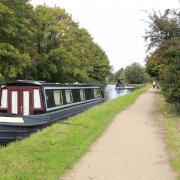From the bright lights, fresh air and fun of the holiday resorts, to quiet secluded spots; from a remote island with more seals than people to one of the world’s most vibrant cities; and from globally-important wildlife sites to, well... more globally-important wildlife sites, this really is the coast with the most.
LANCASHIRE

Cleveleys
While it may not have the biggest beach, Cleveleys can make a strong claim for having the best. The beach here is just across the road from the town centre shops – and just a few minutes walk from the tram stop – and is home to a series of artworks and there are fine views to the Lakeland fells and (on a clear day) the Welsh hills.
No visit to the seaside would be complete without candy floss, a stick of rock, a kiss me quick hat and a portion of fish and chips. While many seaside resorts have been re-born in recent years (and plenty of others have been left to die) Cleveleys has simply plodded on, doing what it has done for generations.

St Annes
St Annes Parish Church was commissioned by local landowner Lady Eleanor Clifton of Lytham Hall in the early 1870s and was named in honour of her aunt Anne. As the town developed in the following years, it took the church’s name. The town was mostly laid out according to a plan drawn up by Rossendale businessman Elijah Hargreaves, who saw there was money to be made from bringing workers from mill towns to the coast.
And the town has lost none of its appeal in the intervening years. There’s a decent range of shops, pubs, cafes and restaurants in the town and lots of traditional seaside fun to be had on the vast beach, or in the promenade gardens.

Fleetwood
This is a tough town that’s full of surprises. The fishing industry that kept the town afloat for decades may have all but gone, but there are reminders of it across town. This is the home of the home of the Fisherman’s Friend lozenge, owned by the Lofthouse family whose matriarch Doreen gave so much to town in her life and left it more than £40m when she died in 2021. Along with many community projects, she funded the life-size replica of the famous Eros statue that stands on a roundabout on the main road into town.
Visitors are also drawn by the public artworks on the sweeping promenade, the glorious views across Morecambe Bay, and the range of events at the Marine Hall.
MERSEYSIDE

Liverpool
In September 1928 city officials organised an official wedding ceremony to marry Liverpool and the sea to solemnise their everlasting partnership. The then Lord Mayor of Liverpool dropped a four foot wide laurel wreath into the Mersey, followed by a 20cm diameter gold covered bronze ring.
There are reminders of Liverpool’s maritime heritage across the city and the area around Albert Dock is now home to museums, galleries and restaurants. The city’s most famous residents are Bella and Bertie, the Liver Birds; Bella looks out to sea to ensure the boats arrive safely into port while Bertie keeps his looks protectively over the city.

Formby
Formby is closely identified with its beach and nature haven, which is in the care of the National Trust. There are some great views and lovely walks around the sand dunes and coastal pinewoods with some, such as The Asparagus Trail, suitable for pushchairs. Other walking trails include butterfly trails and woodland walks. There are cycle routes too and you can also take your horse along the beach.
Formby is famous for its red squirrels but don’t overlook other species which abound here: sand lizards, natterjack toads, mining bees and hosts of birds and butterflies. It’s also a good place to spot wildflowers like the creeping willow the bees like to feed from. Formby Village has wide tree-lined pavements, plenty of shops, good cafes and several pubs, bars and restaurants.

Crosby
Crosby is a regular in lists on the best places to live in the UK, and it’s easy to see what makes it so popular. There’s a pleasing range of shops, cafes, pubs and restaurants, plenty of good schools and some lovely parks and green spaces.
A 19th century First Lord of the Admiralty – who would have known a thing or two about sea views – said the vista from the Crosby coast was second only to the Bay of Naples and it has arguably been enhanced by artist Anthony Gormley’s Another Place, 100 iron men who stand dotted around the sands. Initially planned as a temporary feature, the figures have seen the tides come and go and the sun set on the distant horizon here since 2005.
CUMBRIA

Arnside
Arnside and Silverdale are distinct seaside villages each with a charm of their own, but they share much of a stunning stretch of coastline, views over Morecambe Bay and an official joint designation as an area of outstanding natural beauty. One of the smallest AONBs, it covers 29 square miles between the Kent Estuary, the River Keer and the A6. It was designated in 1972 and it overlaps with 19 Sites of Special Scientific Interest, making this one of our most important areas for wildlife.
The walks are lovely, and there are plenty of pubs and cafes and the views are stunning, particularly from a train on the viaduct over the River Kent – it's one of the region’s great railway journeys.

Piel Island
We do quirky very well around Lancashire and that is demonstrated perfectly on this beautiful island. Anywhere else it would probably be most famous for its 14th century castle, glorious views, its birdlife or its colony of seals who are said to outnumber locals by 80 to 1. It might also be known for its solitude and the hazards of getting here – drivers need a permit to make the journey from Nab Point on Walney Island and the skeletons of abandoned vehicles in the slime illustrate just how dangerous it can be.
Here though it’s best known for the tradition that sees each new landlord of the Ship Inn being crowned King of Piel in a ceremony that involves having beer poured over their head.

Grange-over-Sands
With its stunning views across Morecambe Bay and its proximity to the Lake District, Grange-over-Sands has been attracting visitors for centuries and was known in Edwardian times as the “Torquay of the North”. The town developed with the coming of the railway in the mid-1800s when hotels and health-related hydropathic establishments were built. Piers were also built at the bottom of Bailey Lane and Clare House Lane to take steamers from Morecambe and Blackpool.
The steamers are long gone, but Grange remains a popular spot for a genteel day by the coast. The town has spectacular views across the Bay as well as a good selection of shops, some great cafes and pubs, a mile-long traffic-free promenade and Ornamental Gardens.




